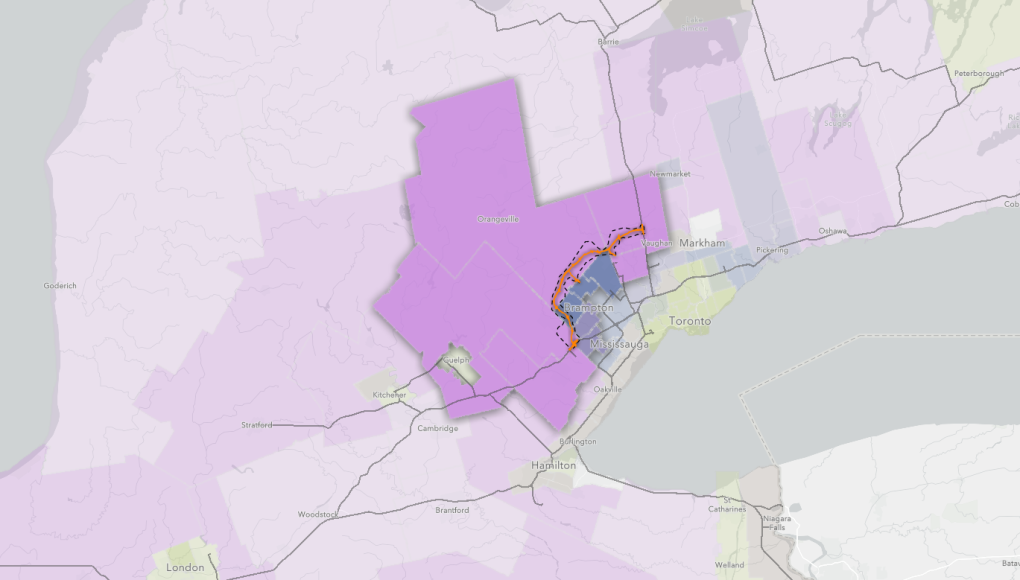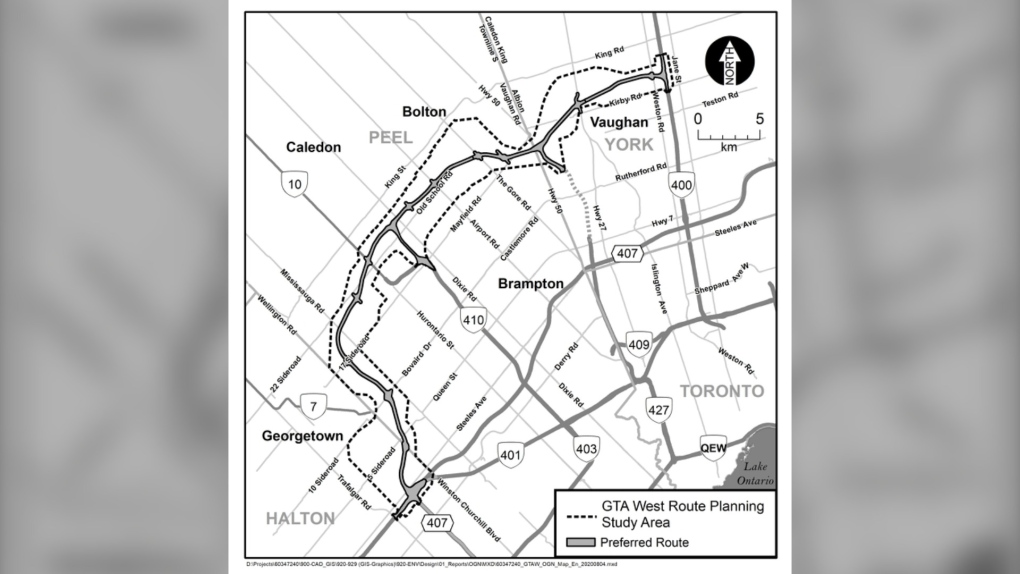About 17.5K people sign petition to stop Highway 413 in Ontario
 A map of proposed Highway 413 and the ridings it travels through. (Environics Analytics)
A map of proposed Highway 413 and the ridings it travels through. (Environics Analytics)
About 17,500 people have now signed a petition asking the federal government to intervene and stop Ontario’s plan to build Highway 413.
The David Suzuki foundation first launched a petition to halt the proposed highway last year, asking Canada’s Minister of Environment and Climate Change to put a stop to the project.
“The highway has to go through a federal impact assessment, and so we're saying to Minister (Steven) Guilbeau, ‘You need to look into this, this is a serious matter and you need to be weighing in,’” Gideon Forman, a transportation policy analyst at the David Suzuki Foundation, told CTV News Toronto.
“Ontarians love their Greenbelt and they don't want to see a new mega highway that will destroy part of (it).”
Forman said the foundation has been in contact with the provincial government, but officials have not been receptive of their concerns.
“They insist that we need this highway. Well, we beg to differ. We think the highway is completely unnecessary and very harmful.”
The six-lane, 52-kilometre proposed roadway was a major campaign pledge for the Doug Ford Progressive Conservatives. Their proposal would see the highway travel from Halton to York Region and connect to highways 401, 407 and 410.
The Ontario government has said it will save commuters about 30 minutes in driving time.
 The proposed route of Highway 413 is shown. (Ontario Ministry of Transportation)
The proposed route of Highway 413 is shown. (Ontario Ministry of Transportation)
Advocates, however, have argued the government is downplaying the impact the new highway would have on the environment, something Forman agrees with.
He said the highway would destroy hundreds of acres of farmland in southern Ontario as well as impact multiple animal species.
“It would cross many rivers and that imperils fish and other animals that live in these river valleys,” he said. “A part of the highway would go just north of Toronto. There's just not a lot of woods and forests and wetlands that are left north of Toronto. So the idea of paving them is just ludicrous.”
“The other piece from a directly selfish point of view is that (it will) cross rivers, like the Humber River and the Credit River, go into Lake Ontario, which is the source of our drinking water in Toronto and many other communities.”
A report published in October 2022 by Canadian environmental advocacy group Environment Defence identifies at least 29 “federally identified species at risk” that will be impacted by the highway.
The report also says the proposed highway would cross about 132 streams and rivers, and result in the loss of about 400 acres of “significant natural areas and/or Greenbelt land.”
“Highway 413 would push endangered species in the area even closer to the brink, while we’re in the midst of a global biodiversity crisis. Some scientists are referring to this period as the sixth great extinction – and Highway 413 would accelerate that,” Keith Brooks, programs director for environmental defence, said in a statement. “It’s unconscionable.”
The government, for its part, has said the preferred route for the highway was chosen “in part to minimize impacts to the Greenbelt.”
In May 2021, the federal government determined Highway 413 warranted designation under the Impact Assessment Act, a piece of legislation that gives them the authority to evaluate how climate change may be impacted by the project.
A spokesperson for Guilbeault’s office told CTV News Toronto the Impact Assessment Agency is waiting for the province to submit its description for the highway before it starts its review.
“Throughout the Impact Assessment Process, the agency will collect science and Indigenous knowledge, and receive feedback from the public and stakeholders,” the spokesperson said.
“At the end of the impact assessment process, the agency will make a recommendation on if the project should or should not move forward as planned.”
The Ontario government, meanwhile, says they have provided the draft project description to the federal government and are working on the final submission.
“This is a complex process, and we are working diligently to meet the requirements so that we can deliver on our plan to build Highway 413 as soon as possible,” spokesperson for the Ministry of Transportation Dakota Brasier said. “Throughout the Environmental Assessment, we will continue to develop refinements and mitigations to minimize any potential impacts that are identified for the project.”
Brasier added that Ontarians voted “overwhelmingly in favour of the government’s plan to get critical infrastructure, like Highway 413, built.”
It is still not clear how much Highway 413 will cost.
A data analysis by Environics Analytics, conducted in May prior to the provincial election, showed that ridings impacted by the highway consist primarily of voters who drive above the provincial average of 22,073 kilometers a year.
CTVNews.ca Top Stories

Couple randomly attacked, 1 stabbed, by group of teens in Toronto, police say
A man has been transported to hospital after police say he was stabbed in a random attack carried out by a group of teens in Toronto on Friday night.
Ron Ellis, who played over 1,000 games with Maple Leafs, dead at 79
Ron Ellis, who played over 1,000 games with the Toronto Maple Leafs and was a member of Canada's team at the 1972 Summit Series, has died at age 79.
Fort Nelson, B.C., wildfire doubles in size as 3,000-plus ordered to evacuate
The wildfire that sparked Friday and caused evacuation orders for more than 3,000 people in Fort Nelson, B.C., and the nearby Fort Nelson First Nation, has grown to nearly 1,700 hectares in size, according to a Saturday morning update from the BC Wildfire Service.
Dutch contestant kicked out of Eurovision hours before tension-plagued song contest final
Hours before the final, Dutch contestant Joost Klein was dramatically booted out by organizers over a backstage incident. He had failed to perform at two dress rehearsals on Friday, and contest organizer the European Broadcasting Union said it was investigating an "incident."
IN PHOTOS Northern lights dance across the night sky in southern Ont.
From London, to Mildmay, Collingwood and St. Thomas, here are some highlights of Friday night and Saturday morning's northern lights display.
Haitians demand the resignation and arrest of the country's police chief after a new gang attack
A growing number of civilians and police officers are demanding the dismissal and arrest of Haiti's police chief as heavily armed gangs launched a new attack in the capital of Port-au-Prince, seizing control of yet another police station early Saturday.
opinion How to use your credit card as a powerful wealth-building tool
Irresponsibly using a credit card can land you in financial trouble, but personal finance columnist Christopher Liew says when used properly, it can be a powerful wealth-building tool that can help grow your credit profile and create new opportunities.
Which Canadian cities have the highest and lowest grocery prices?
Where you live plays a big factor in what you pay at the grocery store. And while it's no secret the same item may have a different price depending on the store, city or province, we wanted to see just how big the differences are, and why.
'We have no judge for you': Man's assault charges dropped weeks before trial due to lack of judges in Toronto
A man who was accused of sexually and physically assaulting a woman had his charges dropped in April, just weeks before he was set to stand trial in Toronto, due to a lack of judges in the region.






























